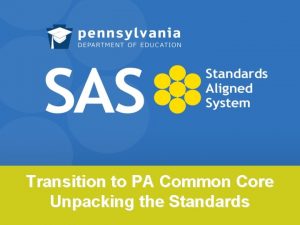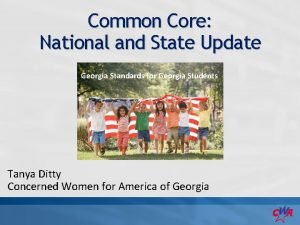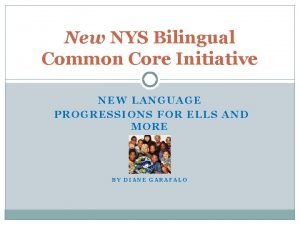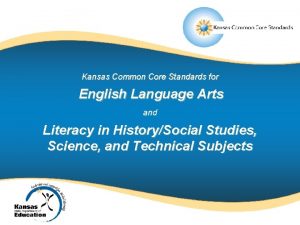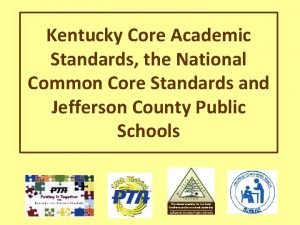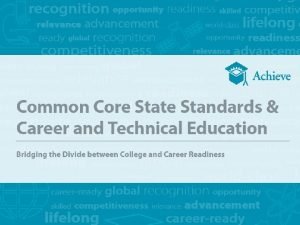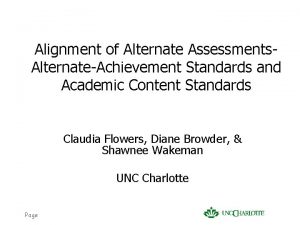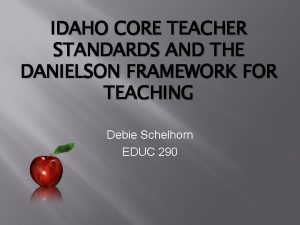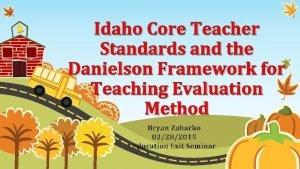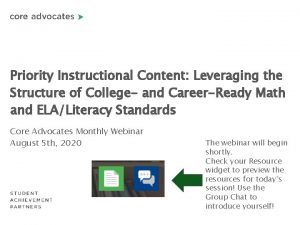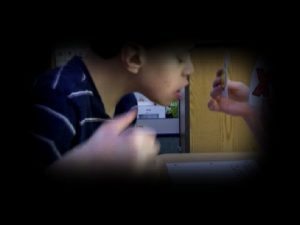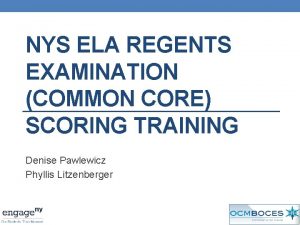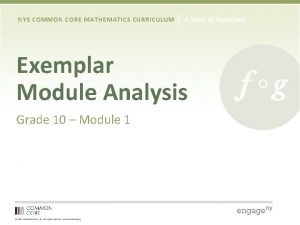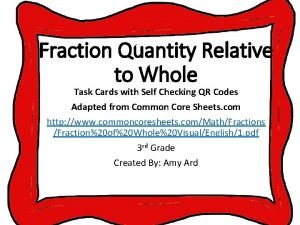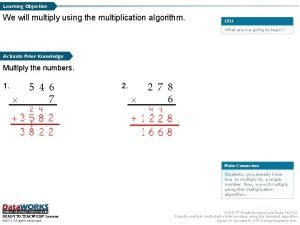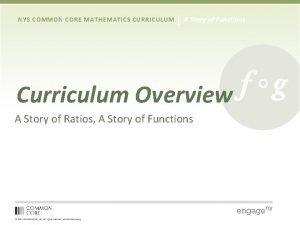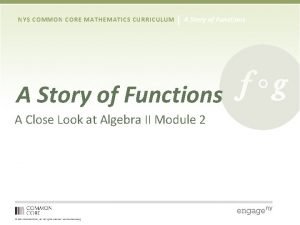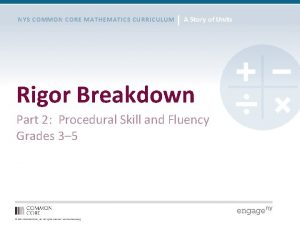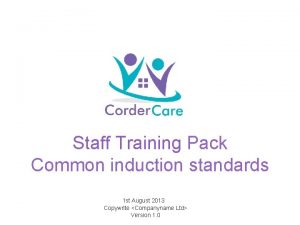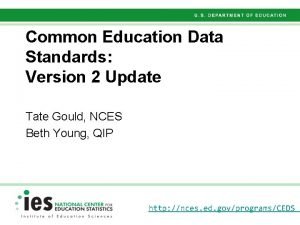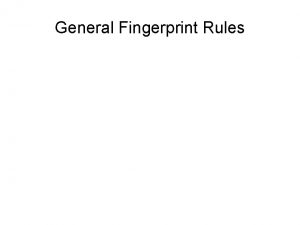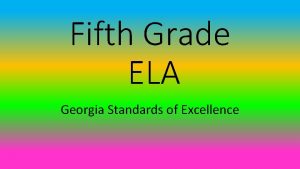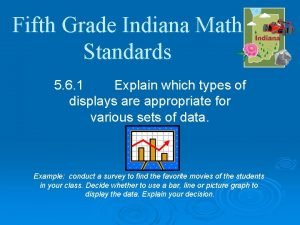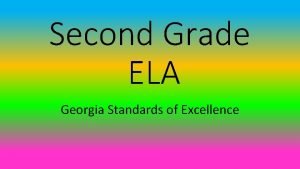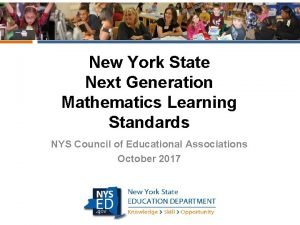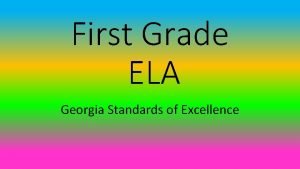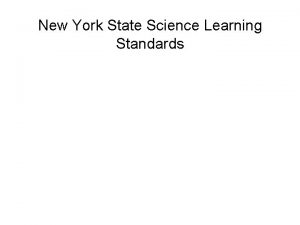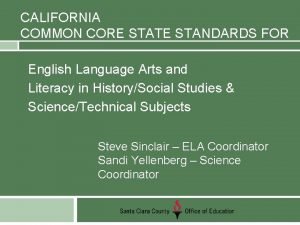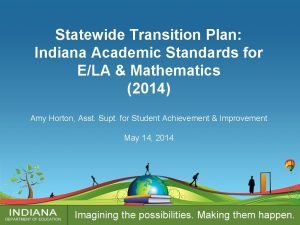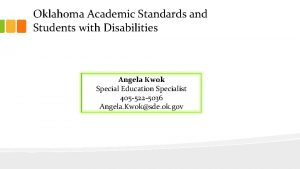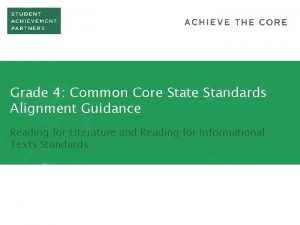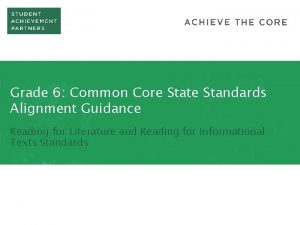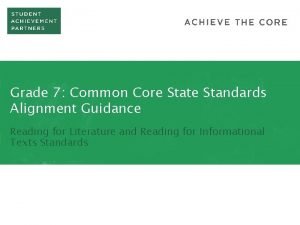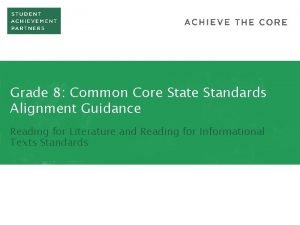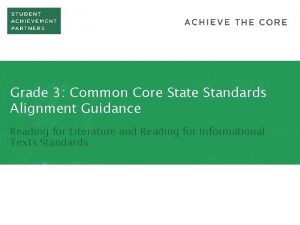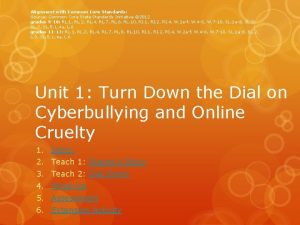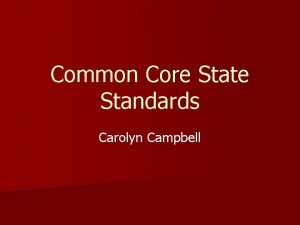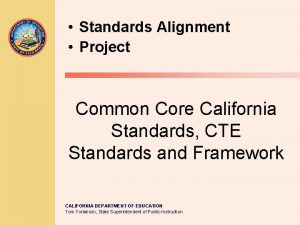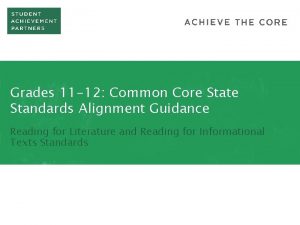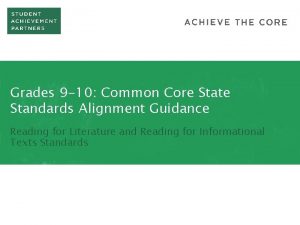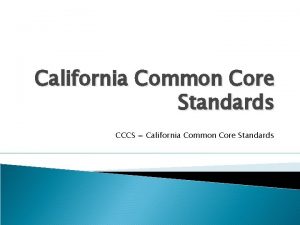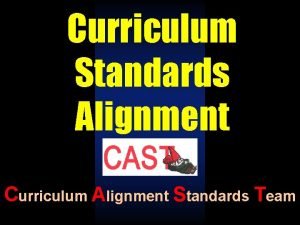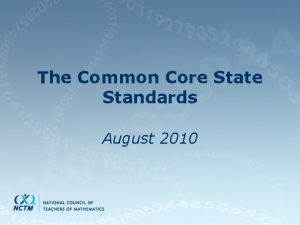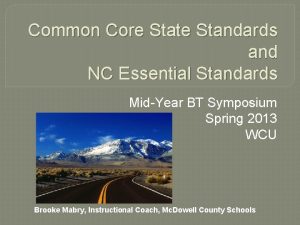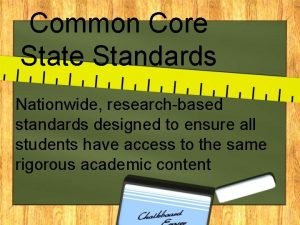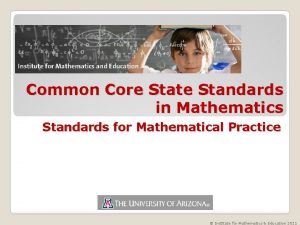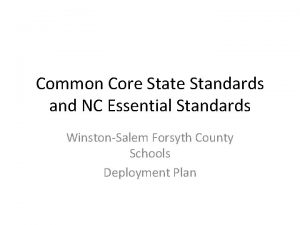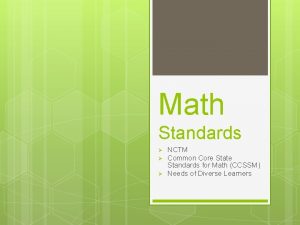Grade 3 Common Core State Standards Alignment Guidance






























































- Slides: 62

Grade 3: Common Core State Standards Alignment Guidance Reading for Literature and Reading for Informational Texts Standards

Session Objective The purpose of these materials is to help develop understanding of the expectations of high-quality summative assessment items. The concepts shown throughout these modules can be useful for classroom questioning and assessment, but the items themselves may need to be slightly modified. PAGE 2

Reading Standards for Literature

Links to Associated Literary Texts The literary sample items are written to the texts linked below. To better understand the points made in each item, you should familiarize yourself with each text. • Because of Winn-Dixie by Kate Di. Camillo • The Fisherman and his Wife by Jacob and Wilhelm Grimm, translated by Lucy Crane • Mrs. Mack by Patricia Polacco PAGE 4

Diving into the Specific Grade-Level Standards Remember that Standards 1 and 10 are bookends requiring: • all passages to be appropriately complex • all items to be answered using textual evidence Items should never be aligned to Standard 1 only. Instead, items should be aligned to Standard 1 and at least one other standard. PAGE 5

CCSS. ELA-Literacy. RL. 3. 2 Recount stories, including fables, folktales, and myths from diverse cultures; determine the central message, lesson or moral and explain how it is conveyed through key details in the text. PAGE 6

What is this story mostly about? A. A new friendship B. A friendly dog C. A frightening bear D. A small library Associated Text: Because of Winn-Dixie by Kate Di. Camillo PAGE 7

Drag and drop the events of the story into the correct order. • Miss Franny tells a story about a bad experience with a bear. • Winn-Dixie and Miss Franny smile at each other. • Miss Franny allows Winn-Dixie to enter the library. • Miss Franny sees Winn-Dixie standing at the library window and thinks he is a bear. • The main character decides she and Winn-Dixie should be friends with Miss Franny. Associated Text: Because of Winn-Dixie by Kate Di. Camillo PAGE 8

Which sentence best explains the central lesson of this passage? A. “I am like my mama in that I like to be told stories. ” B. “He’s a dog who goes to church. ” C. “Let me get a chair and sit down so I can tell this story properly. ” D. “I mean you and me and Winn-Dixie, we could all be friends. ” Associated Text: Because of Winn-Dixie by Kate Di. Camillo PAGE 9

CCSS. ELA-Literacy. RL. 3. 3 Describe characters in a story (e. g. , their traits, motivations, or feelings) and explain how their actions contribute to the sequence of events. PAGE 10

The characters experience many feelings in this text. To complete the question, draw a line from the feeling on the left to the event in the story when a character felt that way. Feeling Frightened Curious Lonely Happy Event When the young girl listens to Miss Franny’s story After Miss Franny’s story is told Miss Franny sees Winn-Dixie at the window When Miss Franny and the young girl decide to be friends Associated Text: Because of Winn-Dixie by Kate Di. Camillo PAGE 11

The following question has two parts. Answer Part A and then answer Part B. Part A: Which word best describes the fisherman in Scene 1? A. Greedy B. Unwise C. Curious D. Kind Part B: Which important event happens because of the correct answer to Part A? A. The fisherman goes fishing every day. B. The fisherman releases the fish back into the water. C. The fisherman tells his wife about the enchanted fish he caught. D. The fisherman tells the fish that his wife wants a better house to live in. Associated Text: “The Fisherman and his Wife” by Jacob and Wilhelm Grimm, translated by Lucy Crane PAGE 12

CCSS. ELA-Literacy. RL. 3. 4 Determine the meaning of words and phrases as they are used in a text, distinguishing literal from nonliteral meaning. PAGE 13

In paragraph 24 of the story, what does the word “peculiar” mean? Choose the correct word from the drop-down menu. Drop-down menu awful lovely unknown strange Text of Paragraph 24 provided for reference: “Well, there was no answer. And I thought it might have been a wild man or a wild woman, scared of all these books and afraid to speak up. But then I became aware of a very peculiar smell, a very strong smell. I raised my eyes slowly. And standing right in front of me was a bear. Yes ma’am. A very large bear. ” Associated Text: Because of Winn-Dixie by Kate Di. Camillo PAGE 14

The following question has two parts. Answer Part A and then answer Part B. Part A: In paragraph 36, what is the meaning of the word recalls? A. remembers B. believes in C. regrets D. is afraid of Part B: Which sentence from the text best helps the reader determine the meaning of recalls? A. “Miss Franny sat there trembling and shaking. ” B. “‘Dogs are not allowed in the Herman W. Block Memorial Library. ’” C. “‘They used to say, ‘Miss Franny, we saw that bear of yours out in the woods today. ’” D. “She sighed again. ” Associated Text: Because of Winn-Dixie by Kate Di. Camillo PAGE 15

In paragraph 14, when Miss Franny says, “mosquitoes so big they could fly away with you, ” what does she mean? A. The mosquitoes ground. B. The mosquitoes C. The mosquitoes D. The mosquitoes were able to lift a child off the were extremely large. were as big as airplanes. were very scary and mean. Text of Paragraph 14 provided for reference: (14) “Back when Florida was wild, when it consisted of nothing but palmetto trees and mosquitoes so big they could fly away with you, ” Miss Franny Block started in, “and I was just a little girl no bigger than you, my father, Herman W. Block, told me that I could have anything I wanted for my birthday. Anything at all. ” Associated Text: Because of Winn-Dixie by Kate Di. Camillo PAGE 16

CCSS. ELA-Literacy. RL. 3. 5 Refer to parts of stories, dramas, and poems when writing or speaking about a text, using terms such as chapter, scene, and stanza; describe how each successive part builds on earlier sections. PAGE 17

The following item has two parts. Answer Part A and then answer Part B. Part A: Which statement best describes how this passage is structured? A. Problem/solution B. Cause/effect C. Order of events D. Description Part B: Which event comes first in the story? A. The wife asks for a cottage. B. The fisherman returns to ask the fish for a castle. C. The sea begins to smell bad. D. The fish gets angry and punishes the fisherman and his wife. Associated Text: “The Fisherman and his Wife” by Jacob and Wilhelm Grimm, translated by Lucy Crane PAGE 18

The following question has two parts. Answer Part A and then answer Part B. Part A: How does Scene 2 of the story build on Scene 1? A. Scene 1 shows that the wife is thankful for her husband, and Scene 2 allows the reader to see that the husband is thankful for his wife. B. Scene 1 shows the wife is unhappy with her home, and Scene 2 allows the reader to see that the wife wants more than she needs. C. Scene 1 shows that the husband does not believe the fish is enchanted, and Scene 2 provides proof that it is. D. Scene 1 shows that the wife is greedy, and Scene 2 shows that the husband becomes greedy as well. Part B: Which sentence from Scene 2 supports the answer to Part A? A. “‘I think the flounder had better get us a larger house. ’” B. “‘Go home with you, she is already standing before the door, ’ said the flounder. ” C. “‘There!’ said the wife, ‘is not this beautiful? ’” D. “‘Oh yes, ’ said the man, ‘if it will only last we can live in this fine castle and be very well contented. ’” Associated Text: “The Fisherman and his Wife” by Jacob and Wilhelm Grimm, translated by Lucy Crane PAGE 19

CCSS. ELA-Literacy. RL. 3. 6 Distinguish their own point of view from that of the narrator or those of the characters. PAGE 20

Who is telling this story? A. The wife B. The fish C. The fisherman D. Someone other than one of the characters Associated Text: “The Fisherman and his Wife” by Jacob and Wilhelm Grimm, translated by Lucy Crane PAGE 21

What is the wife’s point of view about the fish? A. It is something she can use to make her life better. B. It is something she can learn a lesson from. C. It is something she wants to keep as a pet. D. It is something she wants to feed her family. What is the result of this point of view? A. It causes her to want more things than her home can fit. B. It causes her to keep asking the fish for bigger and bigger homes. C. It causes her to push her husband to try to catch the fish many times. D. It causes her to be thankful towards her husband. PAGE 22

CCSS. ELA-Literacy. RL. 3. 7 Explain how specific aspects of a text’s illustrations contribute to what is conveyed by the words in a story (e. g. , create mood, emphasize aspects of a character or setting). PAGE 23

Picture from the book Mrs. Mack by Patricia Polacco PAGE 24

Write one sentence that describes what is happening in this picture. PAGE 25

What part of the story does this picture best explain? A. How lonely the main character feels before she makes friends in Dogpatch B. Which kind of horse the main character loves most C. What Dogpatch looks like when the main character arrives D. How much the main character loves horses Associated Text: Mrs. Mack by Patricia Polacco PAGE 26

CCSS. ELA-Literacy. RL. 3. 8 Standard 8 does not apply to literary texts. PAGE 27

CCSS. ELA-Literacy. RL. 3. 9 Compare and contrast themes, setting, and plots of stories written by the same author about the same or similar characters (e. g. , in books for a series). PAGE 28

The following question has two parts. Answer Part A and then answer Part B. Part A: Which statement best describes a lesson from Text 1, “The Woman with Snakeskin Boots”? A. B. C. D. We can find something good in every situation. Animals make the best friends. We can accomplish more through teamwork. People will support you if you earn their respect. Part B: Which sentence from Text 1 best supports the answer to Part A? A. “‘Show Pat around, ’ Mrs. Mack said as she pushed me toward them. ” B. “‘That one there is Apache!’ she said, pointing to a horse out in the corral. ” C. “‘Ain’t she grand!’ Donnie said as if he’d forgotten I was there. D. “Suddenly, it didn’t matter that I was in Dogpatch, or that these kids didn’t like me. ” Associated Text: Mrs. Mack by Patricia Polacco PAGE 29

How does the narrator’s opinion of Dogpatch change between the two texts? A. She enjoys Dogpatch at first, but then she resents being sent there. B. She feels uncomfortable in Dogpatch at first, but then she grows to love it. C. She overcomes her first fears of Dogpatch, but she continues to feel lonely there. D. She has never seen anything like Dogpatch, but she is happy to leave at the end of the summer. Associated Text: Mrs. Mack by Patricia Polacco PAGE 30

Bottom Line for Reading for Literature Standards Questions are – based on texts that are of appropriate complexity. They are worthy of students’ attention. (Standard 10). Questions require – students to read closely and think deeply about key ideas and specifics of the texts. They are questions worth answering. – students to use textual evidence to help them formulate their responses. They help prepare students for the demands of careers and college. (Standard 1) PAGE 31

Reading Standards for Informational Text

Links to Associated Informational Texts The informational items are written to the texts linked below. • Basic Archaeology: “What’s a Dig? ” and “What’s a Midden? ” from socialstudiesforkids. com • “Cactus Jam” by Ruth J. Luhrs PAGE 33

Diving into the Specific Grade-Level Standards Remember that Standards 1 and 10 are bookends requiring: • all passages to be appropriately complex • all items to be answered using textual evidence PAGE 34

CCSS. ELA-Literacy. RI. 3. 2 Determine the main idea of a text; recount the key details and explain how they support the main idea. PAGE 35

What detail is unimportant and could be left out of Article 1 of Basic Archaeology? A. “One of the main things archaeologists do in their line of work is the dig. ” B. “This is a project designed to find out more about a specific area and what it was like many, many years ago. ” C. “It's not that the ground has really sunk; it's more that more layers have been added on top. ” D. “So, archaeologists use their pickaxes and their drills and their brushes to find and piece together clues to what happened in an area's past. ” Associated Texts: Basic Archaeology: “What’s a Dig? ” and “What’s a Midden? ” from socialstudiesforkids. com PAGE 36

What is one of the main ideas in the passage? A. Groups of Tohono O’odham make jam by doing different jobs and working together. B. The Tohono O’odham make food from different plants they find in the desert. C. Groups of Tohono O’odham enjoy working outside in the summer. D. The Tohono O’odham enjoy having a special sweet treat at the end of a busy day. Associated Text: “Cactus Jam” by Ruth J. Luhrs PAGE 37

The following question has two parts. Answer Part A and then answer Part B. Part A: What is one of the main ideas in the passage? A. B. C. D. Groups of Tohono O’odham make jam by doing different jobs and working together. The Tohono O’odham make food from different plants they find in the desert. Groups of Tohono O’odham enjoy working outside in the summer. The Tohono O’odham enjoy having a special sweet treat at the end of a busy day. Part B: Which three details from the passage best support the main idea in Part A? A. B. C. D. E. F. G. The Tohono O’odham live in the Arizona desert. The saguaro fruit grows at the top of the cactus and at the ends of its arms. The young women and children gather the fruit from the cactus plants. The men make a shelter and build fires for cooking. The older women scrape the fruit out of its peel, cook it, and strain it. The more it cooks, the thicker and sweeter the jam gets. When the jam is ready, children spread it on bread and eat all they can. Associated Text: “Cactus Jam” by Ruth J. Luhrs PAGE 38

CCSS. ELA-Literacy. RI. 3. 3 Describe the relationship between a series of historical events, scientific ideas or concepts, or steps in technical procedures in a text, using language that pertains to time, sequence, and cause/effect. PAGE 39

What is the last step in making cactus jam? A. The fruits are scraped out of their peel and cooked. B. The juice is cooked until it gets thick. C. The fruits are knocked down from the cactus. D. The juice is poured through a strainer. Associated Text: “Cactus Jam” by Ruth J. Luhrs PAGE 40

Part A: What are the steps for making jam? Drag each step in the correct box to show the order of the steps for making jam. The fruits are scraped out of their peel and cooked. The fruits are STEPS FOR knocked down MAKING from the cactus. JAM The juice is cooked until it gets thick. Step 1 The juice is poured through a strainer. Step 2 Step 3 Step 4 Associated Text: “Cactus Jam” by Ruth J. Luhrs PAGE 41

Item continued from the previous slide Part B: What has to happen before Step 1 can start? A. The children have to take their baskets of fruit to the shelter. B. The fruit has to ripen and split open. C. The women have to take the seeds out of the fruit. D. The men have to build the fires for cooking. Associated Text: “Cactus Jam” by Ruth J. Luhrs PAGE 42

CCSS. ELA-Literacy. RI. 3. 4 Determine the meaning of general academic and domain-specific words and phrases in a text relevant to a grade 3 topic or subject area. PAGE 43

Which sentence below uses the word “piece” in the same way it is used in paragraph 5 of Article 2 of Basic Archaeology? A. May I have a piece of your apple? B. The little girl found a piece of jewelry on the sidewalk. C. I created a nice piece of art. D. We worked long and hard to piece the puzzle together. Associated Texts: Basic Archaeology: “What’s a Dig? ” and “What’s a Midden? ” from socialstudiesforkids. com PAGE 44

The following question has two parts. Answer Part A and then answer Part B. Part A: In paragraph 8 of “Cactus Jam, ” what does the word “feast” mean? A. Clean up the mess made when making jam B. Plant more cactus so jam can be made the next year. C. Get some rest since making jam is hard work. D. Celebrate that the jam making is over. Part B: In paragraph 8, highlight three words that show the Tohono O’odham Indians “feast. ” Associated Text: “Cactus Jam” by Ruth J. Luhrs PAGE 45

CCSS. ELA-Literacy. RI. 3. 5 Use text features and search tools (e. g. , key words, sidebars, hyperlinks) to locate information relevant to a given topic efficiently. PAGE 46

After reading “Cactus Jam, ” a student wants to learn more about the giant saguaro cactus. How would you explain to a classmate where he or she should look for information about the plant? Write an essay that explains where your classmate might be able to find out more about the giant saguaro cactus. Associated Text: “Cactus Jam” by Ruth J. Luhrs PAGE 47

Complete the chart below by choosing the best heading for the section of paragraphs noted and dragging the header to the correct box. Not all headings will be used. Possible Headings (Drag from this box and place in the right spot in the first column below. ) What Does the Fruit Look Like? How Does the Community Celebrate? What are the Roles of Community Members? What is Cactus Jam Made From? Where Do the Tohono O’odham Indians Live? Best Heading for Paragraph Numbers 1 -2 3 -7 8 Associated Text: “Cactus Jam” by Ruth J. Luhrs PAGE 48

CCSS. ELA-Literacy. RI. 3. 6 Distinguish their own point of view from that of the author of a text. PAGE 49

Who is explaining the process of making cactus jam? A. A Tohono woman B. A Tohono man C. A Tohono child D. An author who is not part of the tribe Associated Text: “Cactus Jam” by Ruth J. Luhrs PAGE 50

Read this sentence from the article. “One person’s trash could be another person’s treasure. ” What is another sentence from the article that shows this point of view? A. “It may sound a little silly, but archaeologists can find out a lot about people by looking through their trash. ” B. “People throw away things because those things aren't important or because the people have too much of those things already. ” C. “A people’s trash, especially if it was also trash to the invaders, might be left alone…” D. “Did they wear certain clothes? ” Associated Text: “Basic Archaeology: What’s a Midden” by David White PAGE 51

CCSS. ELA-Literacy. RI. 3. 7 Use information gained from illustrations (e. g. , maps, photographs) and the words in the text to demonstrate understanding of the text (e. g. , where, when, why and how key events occur). PAGE 52

Based on the first picture in “Cactus Jam, ” what does the reader learn about the saguaro cactus? A. It grows in the desert. B. The fruit is red inside. C. It is tall. D. There are many fruit on each cactus. Associated Text: “Cactus Jam” by Ruth J. Luhrs PAGE 53

What does the photograph of a saguaro fruit help the reader understand about making jam? A. The photograph shows that jam made from these fruits will be naturally sweet in flavor. B. The photograph shows that the size of the fruits makes gathering them fun to do. C. The photograph shows that gathering fruits is difficult because the fruits are stuck tightly to the plant. D. The photograph shows that the fruits must be scraped out because they have cactus spines on them. Associated Text: “Cactus Jam” by Ruth J. Luhrs PAGE 54

CCSS. ELA-Literacy. RI. 3. 8 Describe the logical connection between particular sentences and paragraphs in a text (e. g. , comparison, cause/effect, first/second/third in a sequence). PAGE 55

Which word from the text shows that there is an important order to the steps in making cactus jam? A. “Once” B. “July” C. “While” D. “Then” Associated Text: “Cactus Jam” by Ruth J. Luhrs PAGE 56

This question has two parts. First answer Part A and then answer Part B. Part A: Why do the “young women use long poles to knock the fruit down”? A. to avoid getting too near the tall cactus plants B. to be able to reach the fruit high in the air C. to keep the children safe as they receive the fruit D. to stay out of the way of the fruit when it drops down Part B: Which sentence from the passage tells the best reason for the correct answer in Part A? A. “The Tohono O’odham live in the Arizona desert, where the giant saguaro cactus grows. ” B. “Everyone gets ready to help make the jam. ” C. “A saguaro can be up to sixty feet tall, and its fruit grows at the top of the cactus and at the ends of its big arms. ” D. “Children try to catch the fruit in baskets as it falls. ” Associated Text: “Cactus Jam” by Ruth J. Luhrs PAGE 57

CCSS. ELA-Literacy. RI. 3. 9 Compare and contrast the most important points and key details presented in two texts on the same topic. PAGE 58

What question is answered by Article 2 that is not addressed in Article 1? A. What is the definition of a midden? B. What tools do archaeologist use? C. Why do archaeologists dig? D. What types of things might be found in a midden? Associated Texts: Basic Archaeology: “What’s a Dig? ” and “What’s a Midden? ” from socialstudiesforkids. com PAGE 59

How does the discussion of trash in Article 1 compare to the discussion of trash in Article 2? A. Article 1 explains how wasteful people have always been. Article 2 offers proof of the kinds of things people waste. B. Article 1 describes how much trash has been left behind from the past. Article 2 describes how archaeologists clean up the old trash. C. Article 1 describes how trash from the past becomes buried over the years. Article 2 gives more detailed information on how that trash is useful to archaeologists. D. Article 1 describes the things that might have been important to people of the past. Article 2 describes how those things are discovered. Associated Texts: Basic Archaeology: “What’s a Dig? ” and “What’s a Midden? ” from socialstudiesforkids. com PAGE 60

Bottom Line for Reading for Information Standards Questions are – based on texts that are of appropriate complexity. They are worthy of students’ attention. (Standard 10) Questions require – students to read closely and think deeply about key ideas and specifics of the texts. They are questions worth answering. – students to use textual evidence to help them formulate their responses. They help prepare students for the demands of careers and college. (Standard 1) PAGE 61

Thank You!
 Common core state standards pa
Common core state standards pa Common core state standards ct
Common core state standards ct Common core state standards missouri
Common core state standards missouri Common core standards arkansas
Common core standards arkansas Global alignment example
Global alignment example Difference between local and global alignment
Difference between local and global alignment Global alignment vs local alignment
Global alignment vs local alignment Global alignment vs local alignment
Global alignment vs local alignment Global vs local alignment
Global vs local alignment Georgia common core standards
Georgia common core standards New language arts progressions
New language arts progressions Unpack standards template
Unpack standards template Ksde social studies standards
Ksde social studies standards Kentucky core academic standards
Kentucky core academic standards Common career technical core standards
Common career technical core standards 4th grade math jeopardy common core
4th grade math jeopardy common core Balanced occlusion vs balanced articulation
Balanced occlusion vs balanced articulation Indirect guidance strategies
Indirect guidance strategies Alternate standards alignment
Alternate standards alignment Inner core and outer core
Inner core and outer core The central part of the earth below the mantle
The central part of the earth below the mantle What are the 3 main layers of the earth? *
What are the 3 main layers of the earth? * Core rigidity
Core rigidity Core standards of health
Core standards of health Danielson framework summary
Danielson framework summary Idaho core teaching standards
Idaho core teaching standards Achieve the core priority standards
Achieve the core priority standards Utah core math standards
Utah core math standards Factors necessary for appropriate service standards
Factors necessary for appropriate service standards Essential elements standards
Essential elements standards Nys ela regents
Nys ela regents Nys common core math
Nys common core math Essential elements michigan
Essential elements michigan Fraction quantity relative to whole
Fraction quantity relative to whole Common core formative assessments
Common core formative assessments Common core lattice multiplication
Common core lattice multiplication Nys common core mathematics curriculum
Nys common core mathematics curriculum Lesson 4 from circle-ometry to trigonometry
Lesson 4 from circle-ometry to trigonometry Nys common core mathematics curriculum
Nys common core mathematics curriculum Common core ela assessments
Common core ela assessments Common induction standards
Common induction standards Common education data standards
Common education data standards Factors 0f 18
Factors 0f 18 Common anode and common cathode
Common anode and common cathode Factor tree for 56
Factor tree for 56 Lowest common factor
Lowest common factor Factors of 12 and 42
Factors of 12 and 42 Multiples of 9 and 21
Multiples of 9 and 21 Rules in selection of core
Rules in selection of core Inner core physical properties
Inner core physical properties Georgia standards of excellence ela
Georgia standards of excellence ela Indiana state standards math
Indiana state standards math Georgia standards of excellence ela
Georgia standards of excellence ela Next generation math standards grade 2
Next generation math standards grade 2 Oklahoma 3rd grade math standards
Oklahoma 3rd grade math standards Georgia standards of excellence ela
Georgia standards of excellence ela New york state science standards
New york state science standards Nevada state science standards
Nevada state science standards Social emotional learning standards washington state
Social emotional learning standards washington state California state standards english
California state standards english Indiana ela standards
Indiana ela standards I got a reservation
I got a reservation Oklahoma state standards ela
Oklahoma state standards ela
